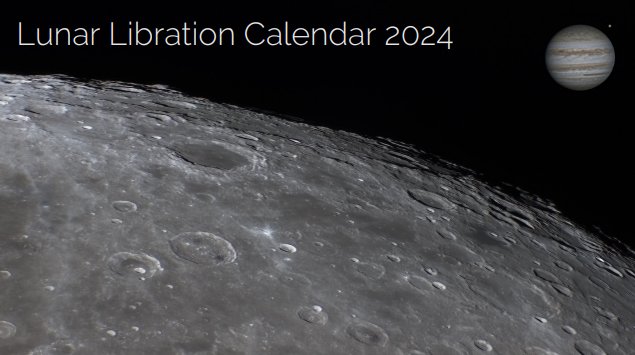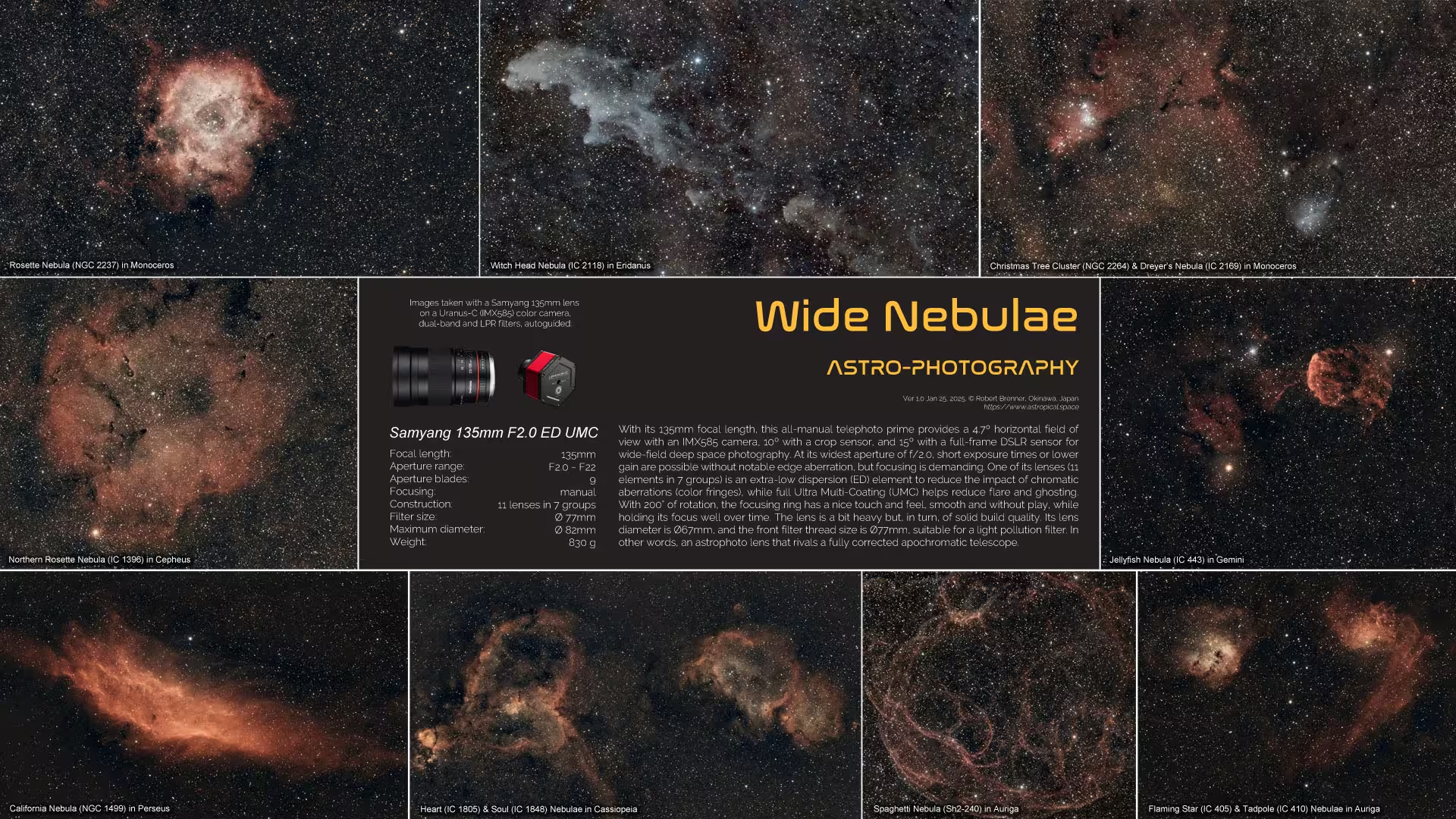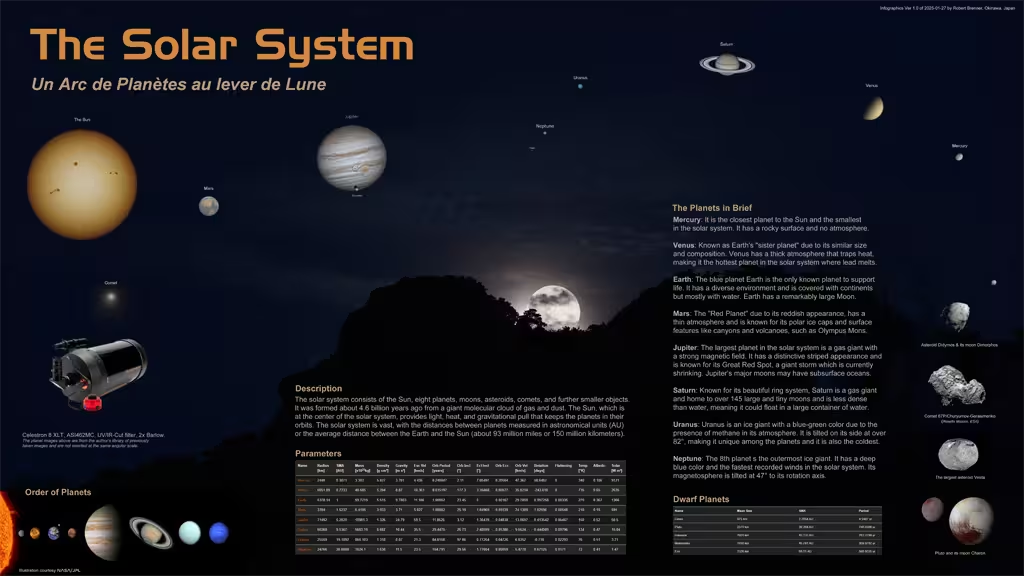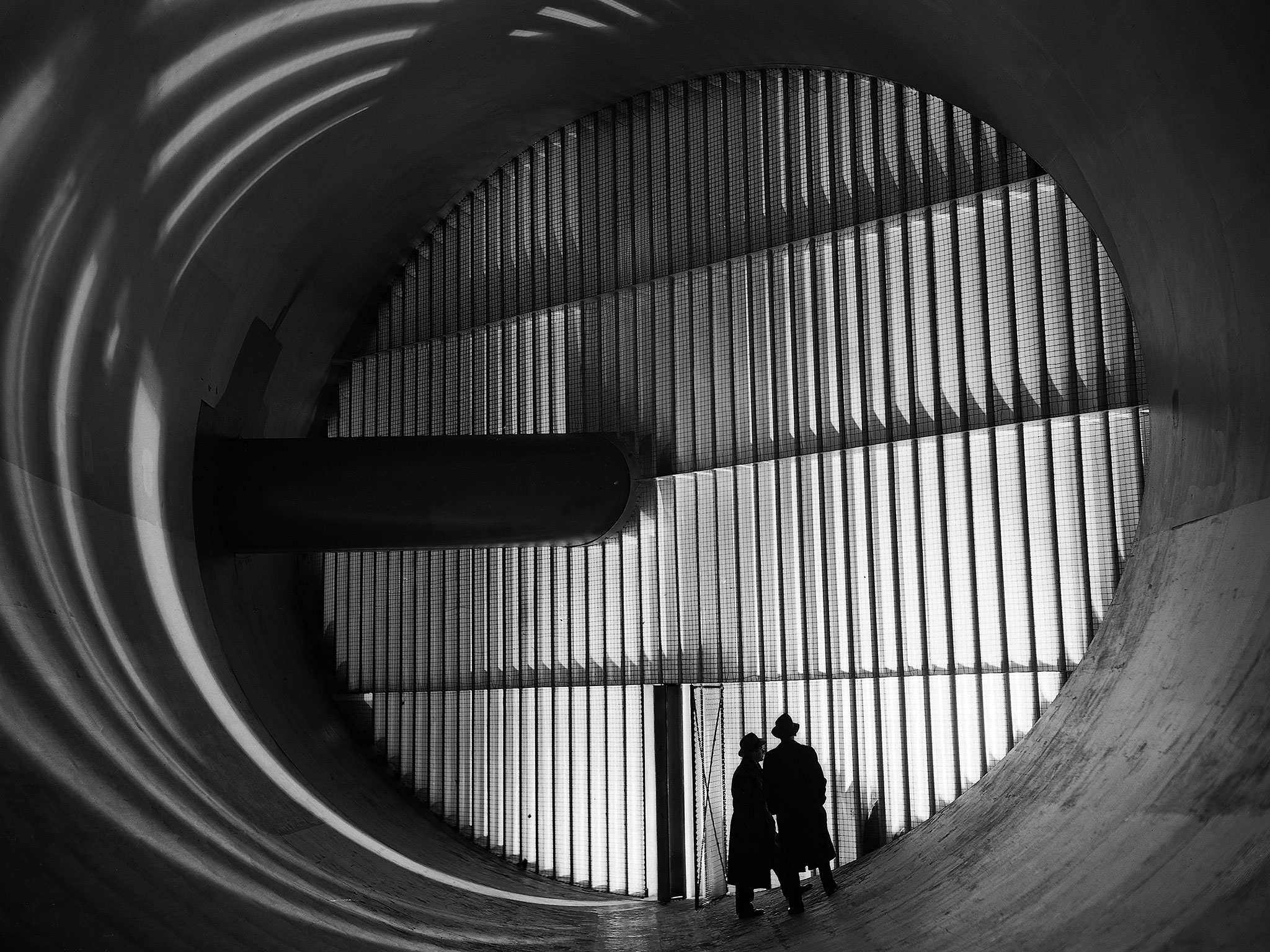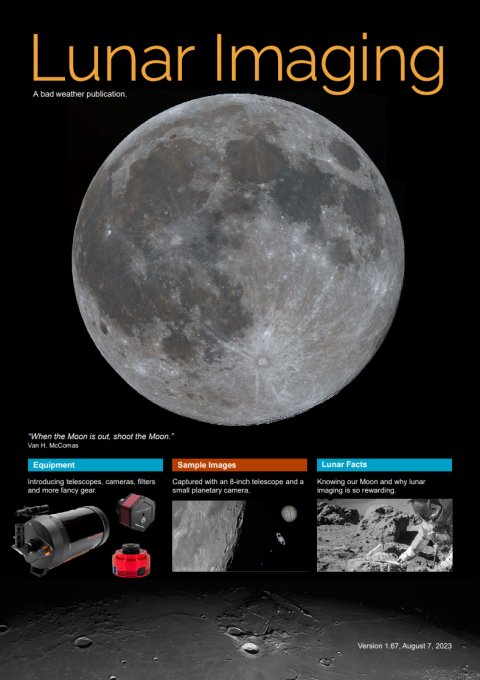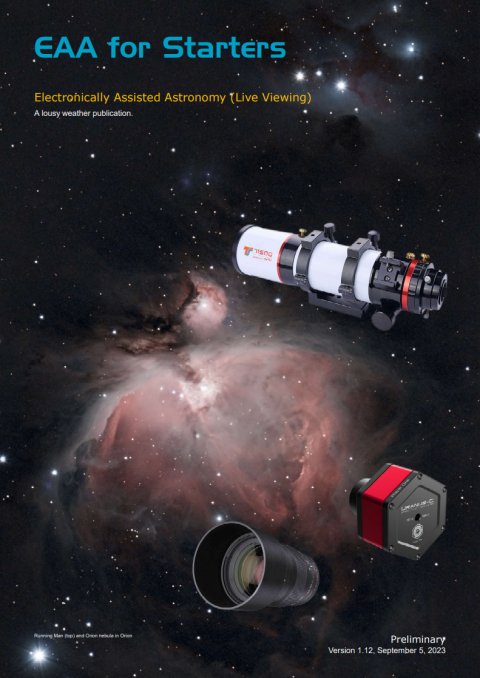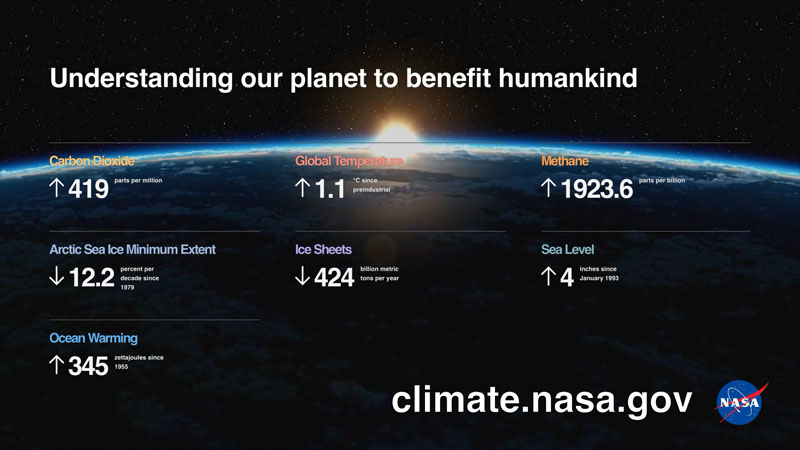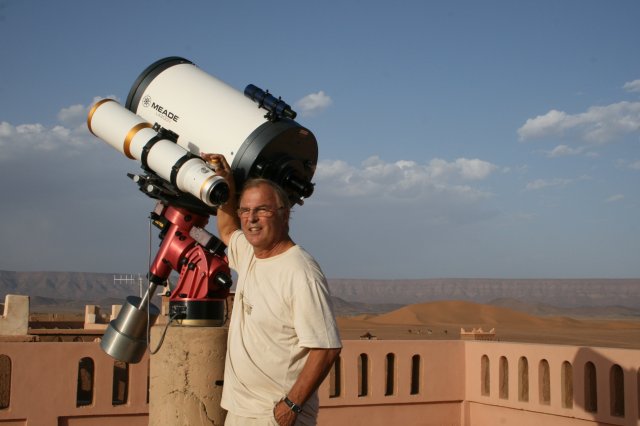Astronomical database with 3D simulations, visualizations, computations, review, articles, and more.
This website is not tailored to smartphones or other hand-held devices.

Sun & Moon Today
Observable comet count is 1188
Current exoplanet count is 5862
Current longitude II of the GRS is 68°
Warning: stripos(): Offset not contained in string in /home3/requio/public_html/index.php on line 305
Impact Probablity of 2024 YR4: Insignificant
| Asteroid | Size | Probability | Date |
| 2024 YR4 | 40—90 m | Insignificant | 22 December 2032 |
Please do not let this worry you. The asteroid has been detected just recently meaning that the orbital elements are not yet accurately determined, while they can alter any time due to gravitational pulls.

The risk corridor of 2024 YR4's possible impact locations runs from the Pacific Ocean to Northern South America, the Atlantic Ocean, central Africa, a corner of the Arabian peninsula, and then to northern India (Source Wikipedia).
Today Monitor
Planet Oppositions
Mars: January 16, 2025
Jupiter: January 10, 2026
Saturn: September 21, 2025
Uranus: November 21, 2025
Neptune: September 23, 2025
Greatest Elongation of Venus
Evening: January 10, 2025 at 47.2°E
Morning: June 1, 2025 at 45.9°W
Greatest Elongation of Mercury
Morning: December 25, 2024 at 22.0°W
Evening: March 8, 2025 at 18.2°E
Morning: April 21, 2025 at 27.4°W
Evening: July 4, 2025 at 25.9°E
Morning: August 19, 2025 at 18.6°W
Evening: October 29, 2025 at 23.9°E
Morning: December 7, 2025 at 20.7°W
Evening: Febrary 19, 2026 at 18.1°E
Super Moons (full) 2025
Wednesday, 5 November
Friday, 5 December
given for 00:00 UT
In Longitude (negative is western)
| Date | Size | Age | Angle | Phase |
|---|---|---|---|---|
| 23 Feb 2025 | 30.61' | 24.48 | -6.502° |  |
| 24 Feb 2025 | 31.06' | 25.48 | -6.683° |  |
| 25 Feb 2025 | 31.54' | 26.48 | -6.463° |  |
| 22 Mar 2025 | 30.16' | 21.97 | -6.602° |  |
| 23 Mar 2025 | 30.54' | 22.97 | -7.220° |  |
| 24 Mar 2025 | 31.00' | 23.97 | -7.497° |  |
| 25 Mar 2025 | 31.50' | 24.97 | -7.380° |  |
| 26 Mar 2025 | 32.03' | 25.97 | -6.841° |  |
| 04 Apr 2025 | 31.86' | 5.54 | 6.674° |  |
| 05 Apr 2025 | 31.40' | 6.54 | 7.159° |  |
| 06 Apr 2025 | 30.97' | 7.54 | 7.233° |  |
| 07 Apr 2025 | 30.58' | 8.54 | 6.935° |  |
| 19 Apr 2025 | 30.14' | 20.54 | -6.609° |  |
| 20 Apr 2025 | 30.49' | 21.54 | -7.247° |  |
| 21 Apr 2025 | 30.91' | 22.54 | -7.602° |  |
| 22 Apr 2025 | 31.38' | 23.54 | -7.618° |  |
| 23 Apr 2025 | 31.89' | 24.54 | -7.248° |  |
| 24 Apr 2025 | 32.39' | 25.54 | -6.459° |  |
| 02 May 2025 | 32.05' | 4.19 | 6.908° |  |
| 03 May 2025 | 31.53' | 5.19 | 7.524° |  |
| 04 May 2025 | 31.04' | 6.19 | 7.652° |  |
| 05 May 2025 | 30.59' | 7.19 | 7.335° |  |
| 06 May 2025 | 30.21' | 8.19 | 6.642° |  |
| 18 May 2025 | 30.56' | 20.19 | -6.624° |  |
| 19 May 2025 | 30.92' | 21.19 | -6.950° |  |
| 20 May 2025 | 31.32' | 22.19 | -7.010° |  |
| 21 May 2025 | 31.75' | 23.19 | -6.758° |  |
| 30 May 2025 | 32.13' | 2.87 | 6.436° |  |
| 31 May 2025 | 31.63' | 3.87 | 7.137° |  |
| 01 Jun 2025 | 31.12' | 4.87 | 7.336° |  |
| 02 Jun 2025 | 30.65' | 5.87 | 7.064° |  |
| 29 Jun 2025 | 31.11' | 3.56 | 6.528° |  |
| 02 Oct 2025 | 30.80' | 10.17 | -6.602° |  |
| 03 Oct 2025 | 31.28' | 11.17 | -6.712° |  |
| 04 Oct 2025 | 31.79' | 12.17 | -6.413° |  |
| 13 Oct 2025 | 32.01' | 21.17 | 6.426° |  |
| 14 Oct 2025 | 31.60' | 22.17 | 7.017° |  |
| 15 Oct 2025 | 31.20' | 23.17 | 7.219° |  |
| 16 Oct 2025 | 30.83' | 24.17 | 7.068° |  |
| 17 Oct 2025 | 30.51' | 25.17 | 6.617° |  |
| 29 Oct 2025 | 30.28' | 7.48 | -6.622° |  |
| 30 Oct 2025 | 30.70' | 8.48 | -7.213° |  |
| 31 Oct 2025 | 31.18' | 9.48 | -7.461° |  |
| 01 Nov 2025 | 31.71' | 10.48 | -7.298° |  |
| 02 Nov 2025 | 32.24' | 11.48 | -6.672° |  |
| 10 Nov 2025 | 32.23' | 19.48 | 7.097° |  |
| 11 Nov 2025 | 31.72' | 20.48 | 7.804° |  |
| 12 Nov 2025 | 31.23' | 21.48 | 8.024° |  |
| 13 Nov 2025 | 30.78' | 22.48 | 7.808° |  |
| 14 Nov 2025 | 30.39' | 23.48 | 7.230° |  |
| 26 Nov 2025 | 30.27' | 5.72 | -6.459° |  |
| 27 Nov 2025 | 30.63' | 6.72 | -7.095° |  |
| 28 Nov 2025 | 31.05' | 7.72 | -7.447° |  |
| 29 Nov 2025 | 31.52' | 8.72 | -7.439° |  |
| 30 Nov 2025 | 32.02' | 9.72 | -7.008° |  |
| 08 Dec 2025 | 32.44' | 17.72 | 6.680° |  |
| 09 Dec 2025 | 31.91' | 18.72 | 7.561° |  |
| 10 Dec 2025 | 31.38' | 19.72 | 7.916° |  |
| 11 Dec 2025 | 30.87' | 20.72 | 7.788° |  |
| 12 Dec 2025 | 30.43' | 21.72 | 7.247° |  |
| 26 Dec 2025 | 31.06' | 5.93 | -6.615° |  |
| 27 Dec 2025 | 31.43' | 6.93 | -6.624° |  |
In Latitude (negative is southern)
| Date | Size | Age | Angle | Phase |
|---|---|---|---|---|
| 12 Jan 2025 | 31.85' | 12.07 | -6.565° |  |
| 13 Jan 2025 | 31.60' | 13.07 | -6.448° |  |
| 26 Jan 2025 | 30.57' | 26.07 | 6.621° |  |
| 27 Jan 2025 | 30.96' | 27.07 | 6.622° |  |
| 08 Feb 2025 | 31.60' | 9.48 | -6.682° |  |
| 09 Feb 2025 | 31.36' | 10.48 | -6.624° |  |
| 22 Feb 2025 | 30.21' | 23.48 | 6.703° |  |
| 23 Feb 2025 | 30.61' | 24.48 | 6.800° |  |
| 24 Feb 2025 | 31.06' | 25.48 | 6.559° |  |
| 07 Mar 2025 | 31.74' | 6.97 | -6.762° |  |
| 08 Mar 2025 | 31.39' | 7.97 | -6.766° |  |
| 09 Mar 2025 | 31.05' | 8.97 | -6.404° |  |
| 21 Mar 2025 | 29.85' | 20.97 | 6.665° |  |
| 22 Mar 2025 | 30.16' | 21.97 | 6.852° |  |
| 23 Mar 2025 | 30.54' | 22.97 | 6.721° |  |
| 03 Apr 2025 | 32.33' | 4.54 | -6.682° |  |
| 04 Apr 2025 | 31.86' | 5.54 | -6.784° |  |
| 05 Apr 2025 | 31.40' | 6.54 | -6.493° |  |
| 17 Apr 2025 | 29.65' | 18.54 | 6.506° |  |
| 18 Apr 2025 | 29.86' | 19.54 | 6.754° |  |
| 19 Apr 2025 | 30.14' | 20.54 | 6.698° |  |
| 30 Apr 2025 | 32.98' | 2.19 | -6.438° |  |
| 01 May 2025 | 32.55' | 3.19 | -6.675° |  |
| 02 May 2025 | 32.05' | 4.19 | -6.485° |  |
| 15 May 2025 | 29.78' | 17.19 | 6.605° |  |
| 16 May 2025 | 29.99' | 18.19 | 6.587° |  |
| 28 May 2025 | 32.97' | 0.87 | -6.528° |  |
| 29 May 2025 | 32.60' | 1.87 | -6.460° |  |
| 11 Jun 2025 | 29.82' | 14.87 | 6.526° |  |
| 12 Jun 2025 | 30.02' | 15.87 | 6.530° |  |
| 24 Jun 2025 | 32.85' | 27.87 | -6.457° |  |
| 25 Jun 2025 | 32.68' | 28.87 | -6.502° |  |
| 08 Jul 2025 | 29.84' | 12.56 | 6.561° |  |
| 09 Jul 2025 | 30.07' | 13.56 | 6.600° |  |
| 21 Jul 2025 | 32.45' | 25.56 | -6.493° |  |
| 22 Jul 2025 | 32.38' | 26.56 | -6.624° |  |
| 04 Aug 2025 | 29.76' | 10.20 | 6.646° |  |
| 05 Aug 2025 | 29.99' | 11.20 | 6.748° |  |
| 06 Aug 2025 | 30.28' | 12.20 | 6.541° |  |
| 17 Aug 2025 | 32.23' | 23.20 | -6.553° |  |
| 18 Aug 2025 | 32.11' | 24.20 | -6.755° |  |
| 19 Aug 2025 | 31.94' | 25.20 | -6.550° |  |
| 31 Aug 2025 | 29.61' | 7.75 | 6.661° |  |
| 01 Sep 2025 | 29.78' | 8.75 | 6.848° |  |
| 02 Sep 2025 | 30.05' | 9.75 | 6.733° |  |
| 13 Sep 2025 | 32.46' | 20.75 | -6.508° |  |
| 14 Sep 2025 | 32.22' | 21.75 | -6.794° |  |
| 15 Sep 2025 | 31.95' | 22.75 | -6.665° |  |
| 27 Sep 2025 | 29.47' | 5.17 | 6.540° |  |
| 28 Sep 2025 | 29.56' | 6.17 | 6.805° |  |
| 29 Sep 2025 | 29.74' | 7.17 | 6.779° |  |
| 30 Sep 2025 | 30.01' | 8.17 | 6.453° |  |
| 11 Oct 2025 | 32.77' | 19.17 | -6.687° |  |
| 12 Oct 2025 | 32.41' | 20.17 | -6.652° |  |
| 25 Oct 2025 | 29.42' | 3.48 | 6.651° |  |
| 26 Oct 2025 | 29.52' | 4.48 | 6.681° |  |
| 27 Oct 2025 | 29.69' | 5.48 | 6.423° |  |
| 07 Nov 2025 | 33.37' | 16.48 | -6.472° |  |
| 08 Nov 2025 | 33.10' | 17.48 | -6.565° |  |
| 21 Nov 2025 | 29.39' | 0.72 | 6.513° |  |
| 22 Nov 2025 | 29.46' | 1.72 | 6.567° |  |
| 05 Dec 2025 | 33.44' | 14.72 | -6.511° |  |
| 18 Dec 2025 | 29.42' | 27.72 | 6.502° |  |
| 19 Dec 2025 | 29.48' | 28.72 | 6.570° |  |
Source: NASA/GSFC
Latest STScI News Release
STScI Astronomer Carol Christian Elected AAAS Fellow

March 27, 2025
Woman with blue sky and puffy white clouds in the background. She has short blonde wind-swept hair. She is wearing dark sunglasses and a green tee-shirt with a V-shaped neckline and short sleeves.
Source: stsci.edu/news
Tonight's Sky
Has been moved to YouTube
Latest JWST News
Webb sees galaxy is mysteriously clearing fog of early Universe
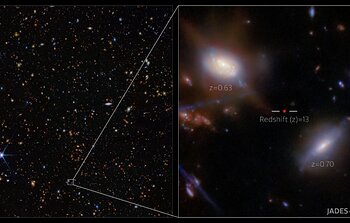
26 March 2025
Using the unique infrared sensitivity of the NASA/ESA/CSA James Webb Space Telescope, researchers can examine ancient galaxies to probe secrets of the early universe. Now, an international team of astronomers has identified bright hydrogen emission from a galaxy in an unexpectedly early time in the Universe’s history. The surprise finding is challenging researchers to explain how this light could have pierced the thick fog of neutral hydrogen that filled space at that time.
Source: esawebb.org
JWST Picture of the Month
Spying a spiral through a cosmic lens
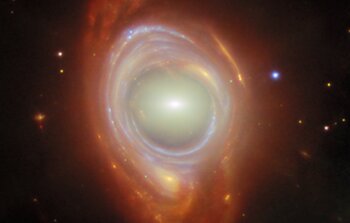
27 March 2025
This new NASA/ESA/CSA James Webb Space Telescope Picture of the Month features a rare cosmic phenomenon called an Einstein ring. What at first appears to be a single, strangely shaped galaxy is actually two galaxies that are separated by a large distance. The closer foreground galaxy sits at the center of the image, while the more distant background galaxy appears to be wrapped around the closer galaxy, forming a ring. Einstein rings occur when light from a very distant object is bent (or ‘lensed’) about a massive intermediate (or ‘lensing’) object. This is possible because spacetime, the fabric of the Universe itself, is bent by mass, and therefore light travelling through space and time is bent as well. This effect is much too subtle to be observed on a local level, but it sometimes becomes clearly observable when dealing with curvatures of light on enormous, astronomical scales, such as when …
Source: esawebb.org
NASA Image of the Day
Turning Vanes inside the Altitude Wind Tunnel
In this February 1944 publicity photo, men stand in front of turning vanes inside the Altitude Wind Tunnel (AWT) at the National Advisory Committee for Aeronautics Aircraft Engine Research Laboratory. The AWT was the only wind tunnel capable of testing full-size aircraft engines in simulated altitude conditions. A large wooden drive fan, located on the other side of these vanes, created wind speeds up to 500 miles per hour.
Click to enlarge or show full screenFri, 28 Mar 2025 16:55 GMT
Source: www.nasa.gov
Direct Images of Gas Giant Planets

Image credit: NASA, ESA, CSA, STScI, W. Balmer (JHU), L. Pueyo (STScI), M. Perrin (STScI)
2025-03-18 Exoplanets
HR 8799 is a young star with 1.5 solar masses, about 130 light-years away in Pegasus and known to have four giant gas planets rich in carbon dioxide gas. NASA’s James Webb Space Telescope took a spectrum and imaged the four planets while the light of the star has been blocked. Link to source 🔗
Barnard's Four Tiny Planets
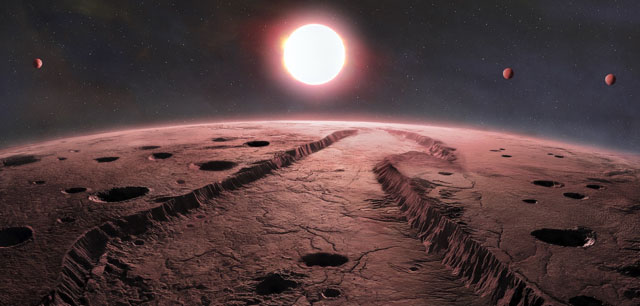
Image credit: International Gemini Observatory/NOIRLab/NSF/AURA/R. Proctor/J. Pollard
2025-03-14 Exoplanets
Next to the Alpha Centauri system, Barnard's star is the second nearest at 5.96 light-years away in Ophiuchus. As of March 2025, the red dwarf star, only 0.16 as massive as the sun, is home to four known (confirmed) planets each of them less than half the mass of Earth and none of them orbiting inside the habitable zone. Only between 2.8 and 4.1 million kilometers away from the star on 2.34 to 6.74 days orbits, their surfaces are supposed to be heat scorched with no outlook for life. Link to source 🔗
Asteroid 2024 YR4
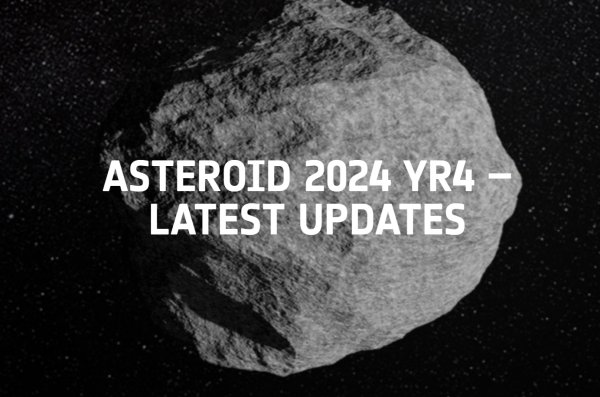
Image credit: European Space Agency
2025-02-07 solar system
2024 YR4 is an extremely faint asteroid with a low albedo of 5% to 25% and is 40 to 90 meters in size which, as of today, has a minute 2.2% probability of impacting Earth at 14:02 UTC on December 22, 2032. The asteroid rotates around its axis every 19.5 minutes and travels around the sun on a highly 0.662 eccentric orbit plane once in about 4 years at a mean distance of 2.5165 AU. Its last perihelion (sun passage) occurred on 2024-Nov-22. The iron-nickel asteroid that created the Barringer Crater in Arizona 50,000 years ago was about 50 meters wide. Link to source 🔗
Nearby Venus-Like Planet
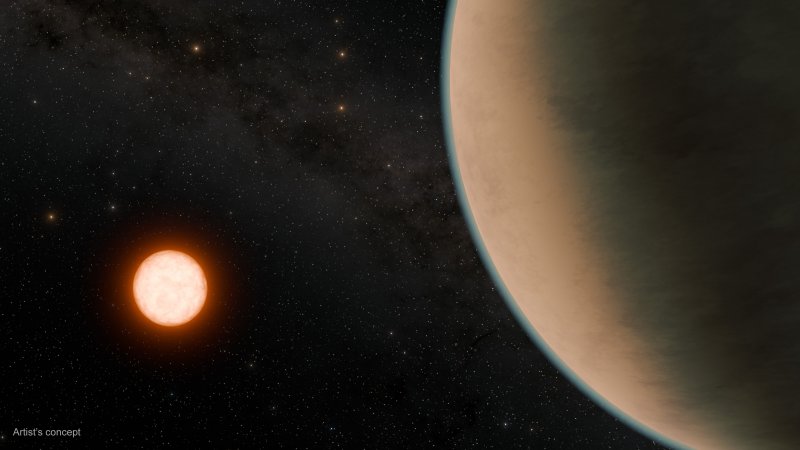
Image credit: NASA/JPL-Caltech/R. Hurt (Caltech-IPAC)
2025-02-01 Exoplanets
Gliese 12 (TOI-6251) is a red dwarf star some 40 light-years away in Pisces. Its known planet, b, about the same size as Venus and, because a red dwarf is much cooler than our sun, the planet also receives the same amount of energy from its host star although orbiting much closer and once in about 12.8 days. In astronomical terms, the planet lies nearby and is a potentially terrestrial, temperate exoplanet inviting further investigations, such as atmospheric spectroscopy with the help of the JWST. Link to source 🔗
New Space Telescope SPHEREx

Image credit: NASA/JPL-Caltech
2025-01-31 Universe
Scheduled for launch past February 2025, SPHEREx is NASA's latest orbiting space telescope, designed for a spectral survey of the entire sky for a duration of tentatively two years in order to explore the origins of the universe. Link to source 🔗
Blackhole Binary

Image credit: NASA / CXC / A. Hobart / Josh Barnes, University of Hawaii / John Hibbard, NRAO
2025-01-20 galaxies
Astronomers at the University of Tokyo discovered a rare quasar-like object with a long-term periodic luminosity variation with a cycle of about 190 days. Two black holes moving periodically at high speed may be the cause of the variability, hypothetically a supermassive blackhole binary. The extremely luminous object lies in the constellation of Hydra and is designated J0909+0002 in short. Link to source 🔗
A new Type of Planet?

Image credit: NAOJ
2025-01-15 Exoplanets
Using the James Webb Space Telescope, astronomers scanned the atmosphere of the planet GJ1214 b located 48 light-years away in Ophiuchus. Instead of a hydrogen rich super-Earth, or a water world, the new data, in spite of many uncertainties, revealed concentrations of carbon-dioxide (CO2) comparable to the levels found in the dense CO2 atmosphere of Venus. Link to source 🔗
Backlog
No, we are not on Facebook but proudly on AstroBin with Mille Gracie to the author Salvatore Iovene:

GoTo Astropical on AstroBin
If anybody is interested in the night life of bats, here is a funny 1-minute MP4 video (24MB).
Recent
1. Certain people appear to enjoy filling forms with random letters for no purpose but insane self-satisfaction. Most of this stupid folks leave their IP addresses which are forwarded to their provider companies. This kind of human crap should not be entitled for using the internet. All so received forms are automatically deleted. Sadly, the world is overfilled with idiots, trolls and criminals. This is a public web site without any sensitive data. No need for these irrational displays.
2. Now in the process of changing all large images to AVIF or WEBP format resulting in considerably reduced file size and download time hardly sacrificing quality as compared with JPEG.
Legal
In case of abuse or hacking attempts, we reserve the right to report to providers, ISPs and legal authorities. The contents of this site is public, no hidden secrets. The data is backed up in regular intervals.
Cookies
This website does NOT send and use "cookies".
Privacy
Your visit is anonymous. The author processes merely the data that a web browser is typically sending back. The only purpose is for the [Visitors Online] section below.
Free Registration
In order for location dependent data to show correctly you need to register. In the interest of your privacy this website does not automatically retrieve your location via third party services, etc.
Compatibility
Website tested under Windows and Android only. Although largely compatible with smartphones this website is primarily designed for desktops, note books and tablets. This applies in particular to database tables. Double click on page top banners to remove them.
Monitor Calibration
Please adjust your monitor's gamma and contrast, etc. if you cannot distinguish all shades of gray. Click for an enlarged color pattern.

URL Request
If you do not wish to register (no problem) but need to see data for your location only once or so, then you can add the following string to the URL:
?lat=xx.xxx&lon=xxx.xxx&tzn=z.zz
where xx.xxx need to be replaced by your geographic coordinates, z.zz with your time zone. This data will not be stored.
This 'once-view' will work for most pages, such as Planisphere, Deepsky Observer, Ephemerides and Today Monitor.
 US, Arizona, Phoenix
US, Arizona, Phoenix US, California, Mountain View
US, California, Mountain ViewLast visit from: CN

on page index.php using Windows O/S.
Unique visitors today: 45 (since 0:00 UTC) from:








Newest flag:  Ukraine -- Welcome!
Ukraine -- Welcome!
Total page views 8882 since 2025-03-01
from 95 different countries (excluding bots & idiots).






























































































Operating SystemsWindows: 5850iPhone: 1018 Macintosh: 919 Linux: 476 Android: 472 Other: 93 iPad: 38 Unknown: 16 |
Most Visitedindex.php: 4040hipparcos.php: 423 starref.php: 367 timeslip.php: 345 algol.php: 331 apscopes.php: 217 php_calendar.php: 201 apmounts.php: 169 caldwell.php: 164 messier.php: 157 |
Site Updates
- https://www.astropical.space/exoplnt.php
- 2025-02-23 • Exoplanet single page fixed.
- 2025-02-17 • ISS Live Cameras fixed.
- 2025-02-17 • Orion Atlas EQ-G Hints added
- 2025-02-16 • EG6-R Pro Mount Review added
- 2025-02-07 • Mounts for AP added
- 2025-01-25 • New Deepsky Poster added
- 2025-01-25 • Lunar Posters added
- 2025-01-20 • Mini Posters added
- 2025-01-02 • Planet ephemerides updated
- 2025-01-01 • Libration calendar updated
- 2024-10-07 • Various minor changes and code fixes
- 2024-10-07 • Aladin removed as not own work
- 2024-05-14 • JWST Images added to Top Page
- 2024-01-09 • Exoplanets with PHL/HWC
- 2023-12-27 • Tomytec Borg telescopes added.
- 2023-12-23 • Takahashi telescopes added.
- 2023-12-21 • Asteroid Dinkinesh & Didymos added.
- 2023-12-18 • Telescopes for AP updated
- 2023-12-02 • Libration calendar 2024 uploaded
- 2023-12-01 • Ephemeris updated for 2024
- 2023-11-16 • Libration data for 2024 updated
- 2023-11-14 • Review BKP150 updated
- 2023-11-13 • Review TS71SDQ updated
- 2023-09-18 • Page Optical Train added
- 2023-10-21 • New PDF brochure added
- 2023-09-18 • Review: Uranus-C added
- 2023-01-21 • EAA for Starters PDF added

Deepsky Overview
My Humble Gallery
Lunar Imaging
FOV Simulator
Astro Cameras
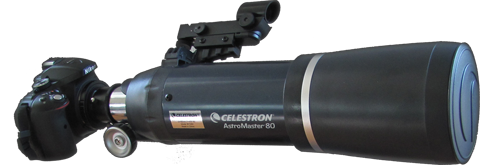
Let's Astrophoto
Telescopes for AP
Total Exoplanet Count: 5862
Kepler/K2: 3326 planetsTESS: 618 planets
Latest exoplanet around:
as of 2025-03-18
| Constellation | Draco |
| Distance | 78.74 parsec |
| Magnitude | 11.11 vis. |
| Mass | 0.71 xSun |
| Radius | 0.72 xSun |
| Temperature | 4975°K |
| Known planet(s) | 2 |
Acton Sky Portal Observatory 2
Anglo-Australian Telescope 35
Apache Point Observatory 1
Arecibo Observatory 3
Atacama Large Millimeter Array (ALMA) 1
Bohyunsan Optical Astronomical Observatory 26
Calar Alto Observatory 22
Cerro Tololo Inter-American Observatory 5
CHaracterising ExOPlanets Satellite (CHEOPS) 3
CoRoT 35
European Southern Observatory 3
European Space Agency (ESA) Gaia Satellite 13
Fred Lawrence Whipple Observatory 6
Gemini Observatory 13
Haleakala Observatory 2
HATNet 67
HATSouth 73
Haute-Provence Observatory 67
Hubble Space Telescope 6
Infrared Survey Facility 1
James Webb Space Telescope (JWST) 1
K2 547
KELT 10
KELT-North 7
KELT-South 4
Kepler 2779
Kitt Peak National Observatory 1
KMTNet 101
KOINet 1
La Silla Observatory 286
Large Binocular Telescope Observatory 3
Las Campanas Observatory 29
Leoncito Astronomical Complex 1
Lick Observatory 36
Lowell Observatory 3
Mauna Kea Observatory 2
McDonald Observatory 31
MEarth Project 2
MOA 31
Multiple Facilities 18
Multiple Observatories 325
NASA Infrared Telescope Facility (IRTF) 1
Next-Generation Transit Survey (NGTS) 21
OGLE 106
Okayama Astrophysical Observatory 36
Palomar Observatory 2
Paranal Observatory 30
Parkes Observatory 2
Qatar 10
Roque de los Muchachos Observatory 35
South African Radio Astronomy Observatory (SAR 1
SPECULOOS Southern Observatory 2
Spitzer Space Telescope 4
Subaru Telescope 11
SuperWASP 113
SuperWASP-North 5
SuperWASP-South 32
Teide Observatory 1
Thueringer Landessternwarte Tautenburg 8
Transiting Exoplanet Survey Satellite (TESS) 618
TrES 5
United Kingdom Infrared Telescope 2
University of Canterbury Mt John Observatory 1
Very Long Baseline Array 1
W. M. Keck Observatory 189
WASP-South 11
Wide-field Infrared Survey Explorer (WISE) Sat 1
Winer Observatory 1
Xinglong Station 2
XO 6
Yunnan Astronomical Observatory 3
Next NEO Approach
2025 FZ1 on 2025-Mar-29 04:21 UTC at 6.4196 LD
Next Meteor Shower
Lyrids
16 Apr - 25 Apr, Peak: 4/22
Radiant: Star Chart, Rating: bright
15 per hour, bright and long lasting meteors. Parent body is Comet C/Thatcher (1861 G1).
Random Objects
Minkar (2 Eps Crv) in Crv [HIP 59316]
Distance: 303 light-years, Magnitude: 3.02
Minkar is an evolved giant with depleted hydrogen. It is 3x more massive, 52x larger (2/3rd of Mercury's orbital size) and 930 times more luminous than the sun. The star is roughly 200 million years old and is rotating very slowly at 1 km/s.
Star Chart | DSS IR Image 🔗Archid A (eta Cassiopeiae A ) in Cassiopeia
Distance: 19 light-years, Magnitude: 3.4
Eta Cassiopeiae (Archid or GJ 34) is a spectroscopic binary pair in a 480 years orbit (eccentricity 0.5) at a mean distance of 71 (36 to 106) AU. The primary is a sun-like star, 97% the mass and 1.04 times the solar radius with a low projected rotational velocity of 3.15 km/s. The companion, B, has 57% the mass of the sun and measures 0.66 solar radii.
Star Chart | DSS IR Image 🔗

M64 (Galaxy) in Coma Berenices
Magnitude: 9.3
Residing about 24 million light years away, M64 extends nearly 40,000 light-years across, spinning around at a speed of 300 km/s. Toward its core is a counter-rotating disc some 4,000 light-years wide causing starburst activity and a distinctive dark dust lane.
Star Chart | DSS IR Image 🔗Sculptor (southern), area rank: 36

A constellation without distinctive stars located south of Cetus. Its constellation picture draws a plaster figure and a table with a chisel on it. In the 18th century, French astronomer Louis de Lacaille introduced Sculptor to fill up space between the constellations.
Star Chart62P/Tsuchinshan 1
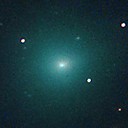
Tsuchinshan 1, is a periodic comet discovered on 1965 January 1 at Purple Mountain Observatory, Nanking.
2002 UX25 (TNO/Cubewano)
Semi-major: 42.54951 AU, Size: 700 km
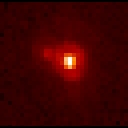
Discovered on October 30, 2002, by the Spacewatch program, 2002 UX25 is a mid-sized Cubewano, redder than Varuna, and, with its absolute magnitude of 3.8, most likely a dwarf planet. 2002 UX25 rotates around its axis in 14.382 hours and has a mass of 1.25x1020kg and, with 0.82±0.11 g/cm³, is less denser than water. A 190 to 260 km wide satellite was detected using the Hubble Space Telescope in August 2005. It orbits the primary in 8.3 days, with a semimajor axis of 4770±40 km.
Umbriel (moon of Uranus)
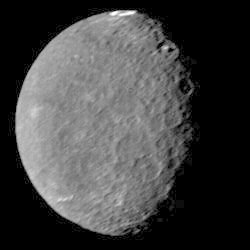
Discovered in 1851, Umbriel is the darkest of Uranus' largest moons. There is a curious bright ring about 140 km in diameter on the moon's dark surface. Umbriel's numerous craters measure up to 210km across. Most of the moon consists of water ice, while the surface is slightly blue in color. Near Umbriel's equator lies the most prominent surface feature, the Wunda crater, about131 km across.
HD 185269 b (in Cygnus)
Mass: 1.01 xJup
SMA: 0.077 AU
Period: 6.83776 days
Distance: 51.9917 parsec
Category: Hot Jovian
ESI: 0.0663695
Android Astronomy Apps
3D Visualizations
Solar System
Planets
Mercury | Venus | Venus Radar | Earth | Earth Melted | Earth Cretaceous | Mars | Mars Terraformed | Jupiter | Saturn | Uranus | Neptune | Planet Nine (hypothetical)Dwarf Planets
Ceres | Pluto | Haumea | Makemake | Eris | KBOAsteroids
Vesta | Pallas (fictive) | Juno (fictive) |Planetary Moons
Ariel (Uranus) | Callisto (Jupiter) | Charon (Pluto) | Dione (Saturn) | Enceladus (Saturn) | Europa (Jupiter) | Ganymede (Jupiter) | Iapetus (Saturn) | Io (Jupiter) | Mimas (Saturn) | Miranda (Uranus) | Moon (Earth) | Oberon (Uranus) | Rhea (Saturn) | Tethys (Saturn) | Titan (Saturn) | Titania (Uranus) | Triton (Neptune) | Umbriel (Uranus)Comets
67P/Churyumov-Gerasimenko (takes a minute to download)Exoplanets
Exoplanets
Rocky Terran | Ocean Terran | Hot Terran | Warm Terran | Desert Terran | Water Terran | Second Earth | Cloud Planet | Jovian Planet | Saturnian PlanetEarth
Beautiful Earth
Earth in hi-res (can take a minute to download)Earth at Night
Panoramic view (can take a minute to download)
